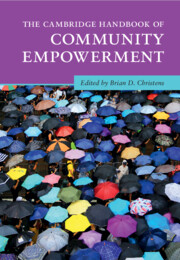Book contents
- The Cambridge Handbook of Community Empowerment
- Cambridge Handbooks in Psychology
- The Cambridge Handbook of Community Empowerment
- Copyright page
- Contents
- Figures
- Tables
- Contributors
- Building Community Power
- Part I Organizing and Activism
- Part II Participatory Governance
- Part III Civil Society and Coalitions
- 11 Community Leadership Development
- 12 Community Coalitions and Empowerment
- 13 Youth-Infused Community Coalitions
- 14 Neighborhood Associations and Community Change
- 15 State-Led Community (Dis)empowerment in China
- Part IV Enterprise
- Part V Participatory and Community Arts
- Part VI Education and Engaged Research
- Contributor Details
- Index
- References
14 - Neighborhood Associations and Community Change
from Part III - Civil Society and Coalitions
Published online by Cambridge University Press: 18 April 2024
- The Cambridge Handbook of Community Empowerment
- Cambridge Handbooks in Psychology
- The Cambridge Handbook of Community Empowerment
- Copyright page
- Contents
- Figures
- Tables
- Contributors
- Building Community Power
- Part I Organizing and Activism
- Part II Participatory Governance
- Part III Civil Society and Coalitions
- 11 Community Leadership Development
- 12 Community Coalitions and Empowerment
- 13 Youth-Infused Community Coalitions
- 14 Neighborhood Associations and Community Change
- 15 State-Led Community (Dis)empowerment in China
- Part IV Enterprise
- Part V Participatory and Community Arts
- Part VI Education and Engaged Research
- Contributor Details
- Index
- References
Summary
Neighborhood associations are geographically bound, grassroots organizations that rely on volunteer membership and direct participation to identify and address issues within their neighborhood. Often these groups serve as intermediaries between residents and local decision-makers, such as government officials, developers and business owners, and providers of public goods and services. As a case example, we describe the Minneapolis Neighborhood Revitalization Program (NRP), launched in 1990. The NRP is a notable long-standing attempt to bolster the role of neighborhood associations in municipal governance. It demonstrates many of the potential benefits as well as the challenges of neighborhood associations as vehicles for locally scaled democracy. After this, we examine dynamics of community power and empowerment processes in neighborhood associations and make recommendations for practice and future research.
Keywords
- Type
- Chapter
- Information
- The Cambridge Handbook of Community Empowerment , pp. 360 - 388Publisher: Cambridge University PressPrint publication year: 2024



